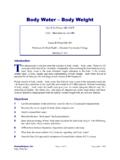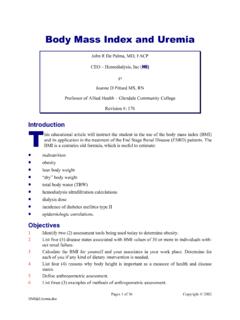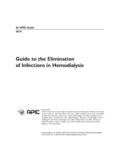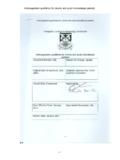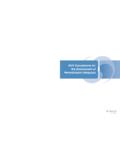Transcription of Dialysis Dose for Contact Hour Credit - Hemodialysis, Inc
1 Dialysis dose John R De Palma, MD, FACP. CEO hemodialysis , Inc (Hi).. Joanne D Pittard MS, RN. Professor of Allied Health Glendale Community College ? Introduction T his article will introduce the student to the concepts of Dialysis dose and adequacy of di- alysis. The student will focus on a single issue, Dialysis dose , and the factors that influ- ence the outcome of the hemodialysis procedure. A basic understanding of the risk factors that contribute to the morbidity and mortality rates of the End Stage Renal Disease (ESRD) pa- tient is necessary to improve patient survival. Objectives 1 Identify two (2) assessment tools being used today to determine the Dialysis dose . 2 Calculate the URR for a Dialysis patient with a pre- Dialysis BUN of 100 mg/dL and a post- Dialysis BUN of 25 mg/dL; converting the results to a percentage. 3 Identify four (4) different methods of post- Dialysis blood sampling that can yield inaccurate test results that influence the formulas of URR and Kt/V.
2 4 Identify the meaning of the formula Kt/V. 5 Identify four (4) problems with the use of the formula Kt/V as an individual assessment tool. 6 Define the term half-life, also called t- . 7 Define the term adequacy of Dialysis . 8 Identify four (4) parameters to assess when using the multiple criteria approach to ade- quacy of Dialysis . D ialysis dose can be defined in general terms as the amount of hemodialysis time re- ceived per Dialysis and the Dialysis frequency per week. Any specific definition of dialy- sis dose must include the frequency per week of Dialysis . Though not mandatory, the di- alysis dose definition should also include the length of time of each Dialysis . There are many formulas for Dialysis dose . Pages 1 of 20. Dialysis dose for Contact hour Credit Save date: December 04, 2000. The most important Dialysis dose , in terms of American Medi-Care reimbursement, is the urea reduction ratio (URR).
3 Partial or full Medi-Care reimbursement for hemodialysis covers almost ninety percent (90%) of United States of America (American) Dialysis reimbursement. Dialysis facilities who care for Americans covered by Medi-Care reimbursement are required by Health Care Financing Administration (HCFA) to submit a Dialysis dose estimation on all Medi-Care bills. Urea Reduction Ratio (URR). HCFA has mandated that the URR1, as the Dialysis dose , be reported on each patient's bill. Fail- ure to include a URR on a Medi-Care bill will result in non-payment. HCFA personnel have also implied and intimated that some time into the future a low URR value on the Medi-Care bill will result in non-payment of said bill. There is precedent for this proposed action. Medi-Care bills which contain hematocrit (Hct) values greater than are reviewed and often are rejected for payment of the erythropoietic drug epoetin.
4 Thus, like the patient's Hct values, the URR is a very important formula and value to know and understand for all ESRD personnel. The URR is a formula which calculates an estimate of the amount of urea removed during one Dialysis . No Dialysis dose definition is complete without knowing the frequency per week of di- alysis when a Dialysis dose is calculated. Dialysis frequency is not part of the formula in deter- mining the URR, making this Dialysis dose value subject to various false interpretations. The URR value, without knowing the frequency of Dialysis per week, is a useless number. The URR describes the amount of urea removed during a single Dialysis by measuring the blood urea nitrogen (BUN). The length of time of that Dialysis can not be inferred from the result of the URR. A high URR will result if a small patient is dialyzed a short period of time. A low URR. occurs in a large patient dialyzed a longer period of time than the small Dialysis patient.
5 The for- mula for URR is: URR = (Pre BUN - Post BUN) Pre BUN. The resulting fraction is often converted to a percentage by multiplying the result by 100. This latter formula is: URR = (Pre BUN - Post BUN) Pre BUN*100. To obtain a URR, blood is drawn from the patient pre- Dialysis , let's assume a BUN (PreBUN) is determined by the laboratory to be 100 mg/dL. If at the end of that same Dialysis a correctly drawn post- Dialysis BUN of 25 mg/dL is determined, then the URR can be calculated as: URR = (100 - 25) 100. This is a URR of .75, a very high value. The URR can be converted to a percentage by multiply- ing the result by one-hundred yields a URR of seventy-five percent (75%). Pages 2 of 20. Dialysis dose for Contact hour Credit Save date: December 04, 2000. Post- Dialysis Blood Drawing Though simple in concept and simple to calculate, the URR is fraught with error because it de- pends on a post Dialysis blood sample.
6 In our experience, the URR results may be inverse to the quality of the education of the Dialysis personnel drawing these blood samples. That would mean that the better trained and knowledgeable nursing staff who draws these blood samples, will re- sult in lower URRs in that Dialysis facility. The less well trained nursing staff who performs care- less, sloppy, and indifferent blood drawing will have URR results that are much higher. Using Blood Drawn From Different Dialysis Days We are aware of Dialysis facilities which use, or at least have used, the pre- Dialysis BUN from the first Dialysis of the week and the post- Dialysis of the last Dialysis of that week. This will result in a URR which is both false and very high. This error invalidates the use of the URR as a estimate of an honest Dialysis dose but is useful in guaranteeing payment of those Medi-Care bills with such URR results.
7 Recirculation, Rinsing, and Rebound 2. Recirculation Most Dialysis patients have A-V fistulas or catheters for semi-permanent access to their blood. Both of these access devices have some degree of recirculation between arterial and venous blood. Unless the post Dialysis blood is drawn deftly and with careful attention to recirculation of blood, the post Dialysis BUN may be higher due to mixture with arterial blood. Rinsing With Saline Post Dialysis If the post Dialysis blood sample is drawn without care to avoid saline contamination, the post Dialysis BUN may be lower due to the presence of that diluting saline solution. Priming the Artificial Kidney All dialyzers and blood lines are primed with normal saline prior to patient use. The pre- Dialysis blood samples should be drawn directly from the patient's arterial access prior to initiating the Dialysis treatment to avoid a pre- Dialysis blood sample that may contain the priming solution.
8 If blood is drawn from the arterial line when Dialysis is being initiated, the pre- Dialysis BUN will be lower due to the presence of saline as a diluent in the blood sample. Urea Rebound Post- Dialysis Present day artificial kidneys are capable of removing urea and other substances from the blood more rapidly than these substances can be transferred from their intra-cellular spaces. Potassium like urea is artificially low post- Dialysis and is probably a much more important solute to assess. Unfortunately, most of the research has focused on post- Dialysis urea rebound and not solutes like potassium, bicarbonate, and phosphate. Pages 3 of 20. Dialysis dose for Contact hour Credit Save date: December 04, 2000. Example of Urea Rebound 100. 90. 80. BUN mg/100cc 70. 60. 50. 40. 30. 20. 10. 0. 0 4 8 12 16 20 24. Hours Figure 1 - Idealized Urea Rebound Figure 1 is a graph depicting an idealized example of post- Dialysis urea rebound following a hemodialysis treatment.
9 The pre- Dialysis BUN is 100 mg/dL. The length of Dialysis is four (4). hours. The immediate post- Dialysis BUN is 30 mg/dL. The BUN is lowest immediately post- Dialysis . The BUN value then rises sharply for about an hour , in this instance, to about 38 mg/dL. This latter BUN is the urea rebound value. The rapid increase in post- Dialysis BUN is believed to be due to intra-cellular urea transfer into the blood compartment. Much medical literature has been devoted to this problem, primarily because the URR result is dependent on the post- Dialysis blood sample's accuracy. Some studies have reported sequential blood samples from patients post- Dialysis and concluded that it may take an hour before a true post- Dialysis blood urea may be determined. Depending on the nursing staff, the post- Dialysis urea rebound may be more artifactual than real. In our experience the un-predictability of the post- Dialysis urea concentration is often due to the careless technique of the Dialysis staff coupled with the issues of: 1 recirculation of blood between arterial and venous needles, 2 saline rinsing post- Dialysis , and not due to slow urea flow from intra-cellular to blood compartment.
10 Kt/V As a Measure of Dialysis dose All the blood drawing errors associated with determining the URR are also associated with the more complex formula called Kt/V3 used in urea kinetic modeling. The Kt/V4 has additional er- rors which are built into the formulas used for Kt/V. The V is an estimate of total body water of the patient. The K is the Klearance (clearance) of that particular artificial kidney and the Pages 4 of 20. Dialysis dose for Contact hour Credit Save date: December 04, 2000. t is the time of actual Dialysis . Of these three (3) variables, the easiest one to assess, control and verify, is t or time on Dialysis . Time on Dialysis Unfortunately the time on Dialysis , the simplest of the three (3) variables, is commonly subject to improper recording in the patient's treatment log. Even in the very best Dialysis facilities there are employees who will write in the total treatment time prior to placing the patient on Dialysis !
